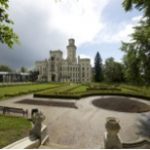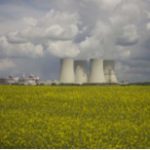Student Reports: Engineering in Prague, Czech Republic, 2014
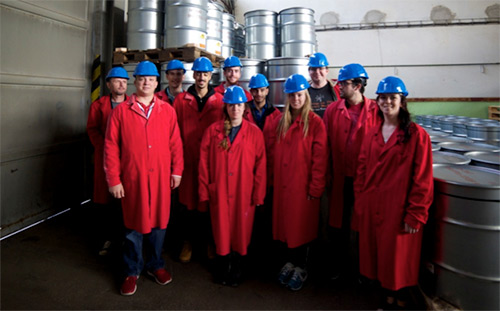
May 10-11, 2014
Eric Welch:
This trip started out early on May 10. And not the 8 am kind of early. The 4 am kind of early. The first task of this trip was to get to Prague. Whether that be as a group or an individual, the goal was the same. I cannot speak for everyone in the study abroad group, but my travel experience was a relatively smooth one, which was the result of the combined efforts among those that traveled in our five-person group, that was on the same flights.
The travel time for our group from Knoxville to Prague took a total of twenty-four hours, with stops in Washington D.C., Montreal, and Zürich. These multiple stops and extended travel time, taught me a few things like: how to purchase and plan an international flight, how to operate international airports, and how to better be a part of a group that looks out for one another in an unfamiliar environment.
The trip to Prague included short layovers, long layovers, many countries, lots of time, and some tight quarters (word of warning for fellow tall travelers-planes are not exactly the roomiest mode of transportation). All in all, the trip from the United States to Europe worked out and provided some bonding moments between the professors and students alike. Everyone arrived on May 11 in Prague, weary eyed and tired from travel, but ready to explore this new place and to gain practical nuclear reactor experience.
May 12
Whitney Smith:
Early Monday morning, the group met downstairs for our first breakfast at the Hotel. Because we had to leave around 6:00 a.m., the hotel prepared the continental breakfast early just for the UT students. Their breakfast consisted of several jelly-filled pastries, lots of salami, bread, and yogurt. After breakfast, we all gathered in the bus and headed for Rozna Uranium Mine. As we traveled into the more rural part of the Czech Republic, we noticed several beautiful fields of this beautiful yellow crop. We found out that the crop is called Rapeseed and is used in making biofuel.
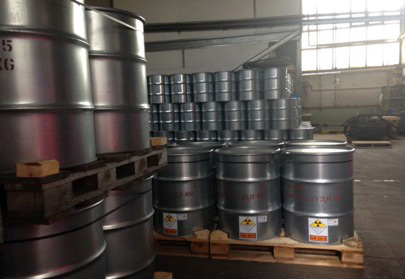
Once we arrived to the Uranium mine, the Rozna employees gave us a lecture on the process of turning Uranium ore into yellow cake. Next, they gave us a tour of the plant starting with the crushed Uranium ore that was mined from the ground. The Uranium ore was then crushed into a sludge using large steel balls with a diameter of 10 cm. In the milling process, the ratio of Uranium to liquid sludge is 1 to 6. Therefore, the sludge goes through a thickening process in order to make the ration 1 to 1.
Next, the sludge goes through alkaline leaching, sorption, and drying to make yellow cake. The tour guide allowed the group to enter the yellow cake storage room. Yellow cake is used to make the fuel pellets in a nuclear reactor.
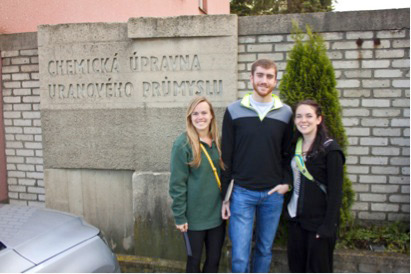
May 13
Chateau Hluboká, Temelin Reactor, and Budweiser Budvor
Whitney Smith:
Tuesday began with a bus trip to see the Chateau Hluboká Castle. The Castle was originally built in the thirteenth century, but it has been rebuilt numerous times. We toured the Princess Eleonore’s bedroom and saw the family’s culture through her fashion and interior decorations. We also toured the game rooms, extravagant dining halls, and the armory. The Gothic style of the Castle was displayed in the intricate woodcarvings of the furniture and doors. We made several group photos in the courtyard in front of the Castle, and visited the first of many souvenir shops.
UT nuclear engineering students visited the Chateau Hluboká Castle, left, and the Temelin Nuclear Power Plant, right.
Our next adventure leads us to the Temelin Nuclear Power Plant. The Temelin Nuclear Power Plant was built in the 1970s and was designed by Westinghouse. On this tour, we saw all the components in the secondary system including the steam generators, turbines, transmission lines, and cooling towers. I had never been so close to the cooling towers of a plant, and their size was much bigger than I ever expected.
To finish off the day, we toured the original Budweiser Budvor brewery. We got to smell the scent of the Moravian malt and Žatec hops mixed with the purified water from the deep wells of the Czech Republic. We went to the underground storage compartments where the beer was being fermented and chilled.
May 14
Czech Nuclear Research Institute and Prague Castle
Whitney Smith:
On Wednesday, we visited the Czech Nuclear Research Institute, which was basically the Oak Ridge National Laboratory of Czech Republic. We were able to see the research being done in nuclear engineering, the different reactors, and how they work. We were able to see the storage of spent fuel and the inside of a reactor vessel.
Next, we went to Prague Castle and saw a more historic part of the city. The Castle is near the St. Vitus Cathedral, where we began our tour. In the Cathedral, we saw the beauty in the stained glass, statues of St. Mary, the pews, and the seat of the Archbishop. The cathedral has a magnificent clock tower that dominates the skyline of the city over 317 feet tall. We traveled the 297 steps up the tower to view the city of Prague. Next, we went to the Castle and saw Vladislav Hall. The wooden floors of this marvelous dining hall have been preserved since the Castle was built. We finished off the day crossing the Charles bridge and having dinner at a traditional pub of Czech Republic.
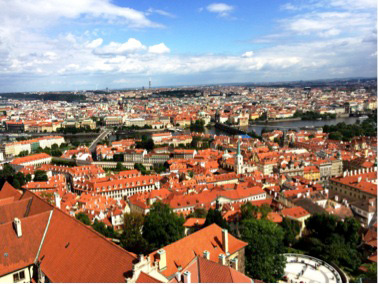
May 15
Travel to Vienna and Belvedere Palace
Eric Welch:
On Thursday morning, we had our bags packed and headed to the metro, which we rode to one of the main train stations in Prague. After finding our platform, all that was left to do was get on the train and enjoy the five-hour trip to Vienna. As a group, I felt that this was one of the best bonding moments. The train ride consisted of group discussion about classes, our lives, and our futures. Before this trip, most of us were acquaintances. Now I feel we are closer, we understand more about each other, and will continue to get to know each other after the trip.
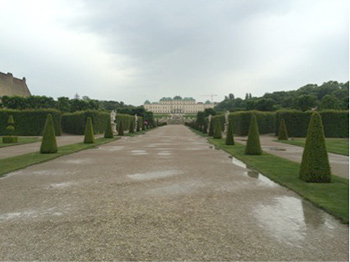
This discussion and time together was intermixed with sleep for those that could and studying (because above all else this was a class). Although, not much studying was accomplished, the excitement for Vienna building within us. After the ride, we exited the train and found our way to the hotel. After dropping our bags off and grabbing a quick bite at a small bakery, we made our way to Belvedere Palace. This palace now functions as a series of art museums, holding art from the obscure to the renowned. By far my favorite piece was the Monet’s Garden in Giverny. Seeing a piece from one of the most famous artists of all time was an experience to remember.
May 16
IAEA Safeguards, United Nations, and CTBTO
Kaitlyn Darby:
Despite having arrived only the day before, we technically left Austria Friday morning as we crossed through yet another security check into the United Nations office in Vienna. It was here that we received what I thought were the two most interesting tours of the trip. Susan Pickett lectured us on IAEA’s (International Atomic Energy Agency) Department of Safeguards. The IAEA was established in 1957 to promote the peaceful use of nuclear material and similarly deter militant uses. The Department of Safeguards is the verification branch of IAEA, meaning that they are the ones that physically take measures to assure that participating States are in compliance with their safeguards agreement and any agreed upon additional protocols.
While we were there, we were shown some of the seals they use to ensure that their on-site devices are not tampered with and then some of the radiation detection devices themselves. The detectors were actually ones we had spent quite a bit of time on in class (NE401). This system acts as essentially a means to prove on an international platform that a State’s nuclear material is being used peacefully. Although the IAEA is given no authority to enforce it statues, it acts as a means by which a country can voluntarily gain its stamp of approval into the international nuclear industry or by which an alarm may be signaled.
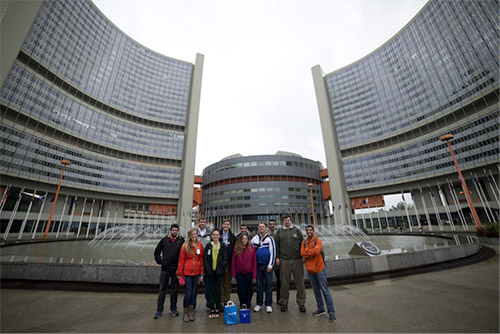
CTBTO is the Comprehensive Nuclear-Test-Ban Treaty Organization. As its name might suggest, it is the organization that seeks and monitors the complete elimination of nuclear explosives anywhere on Earth under the Comprehensive Nuclear-Test-Ban Treaty. Although this treaty has not been ratified by all countries or even all nuclear weapons states, (The United States has not ratified it.) CTBTO is watching the globe for nuclear explosives with a series of over 275 monitoring stations under a preparatory nature and in hopes that the treaty is soon completely ratified.
We were given both an informational lecture and shown the room in which the data monitors are displayed. On the walls were seismic and sub-acoustical responses from each of the monitoring stations around the world. Should a nuclear explosion take place, the stations would report back data indicative of one. The information can also be evaluated for less specific types of monitoring. For example, they were able to show us the data response to the events surrounding the Fukushima Daiichi incidents in 2011.
The final tour we took before leaving the United Nations office was, appropriately, a general United Nations tour. Did you know the official working languages of the UN are English and French but that each of the UN meetings in simultaneously being translated into several other languages through a series of headsets and translators? Rain jackets and all, the tours at the UN were great!
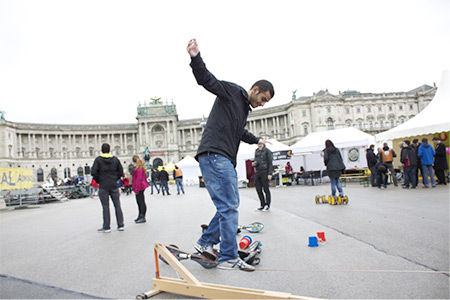
May 17
Exploring Vienna and Travel back to Prague
Kaitlyn Darby:
A few of us woke up early for our last day in Vienna and journeyed out into the city in hopes of touring a rose garden one of us had already been to. Unfortunately, the weather was once again not in our favor, and for some reason the garden had be closed off. Not so unfortunately, after a bit of walking, we ended up at some sort of fair in front of the Hofburg Palace.
Both the home of the Hapsburgs at one point and the location of Hitler’s speech after taking Austria in 1938, this fair was full of fun and history. There were plenty of toys to play with and live entertainment as well as a full on pig roast. It was such an unexpected treat.
We were short on time, so around 11:00 a.m. we headed back to the hotel to check out and have one last meal in Vienna before we departed. After a bit of roaming we decided on street food for lunch and made our way to the train station. Much like our trip to Vienna, the train ride home was five more hours of sleeping, talking, and bonding. With the tours winding down and the labs starting in less than two days, we were all in it together.
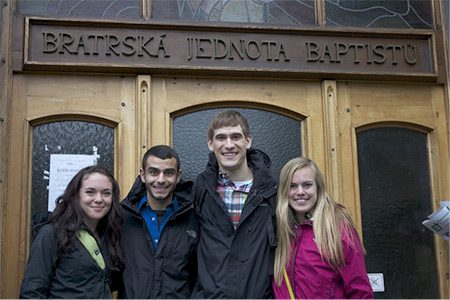
May 18
International Baptist Church of Prague, Ronalda Reagana, and Prague Zoo
Kaitlyn Darby:
We woke up Sunday to our last day before labs began and really the first day that the group split. A few of us had found a church online that we wanted to visit, a few had their hearts set on finding the street named for Ronald Reagan, and some combination of those groups finally met at the Prague Zoo for the rest of the afternoon.
I was in the group that attended church. We found the International Baptist Church of Prague online as part of the Baptist Church of Prague located just a few subway stops away from our hotel. So on Sunday, we left at 10:00 a.m. to find our way there. The subway was fairly easy to navigate by then, and we even had time to stop for coffee down the street from the church.
On our way to the second floor, where the sermon would be given in English, we noticed that both a Czech speaking and a Chinese speaking congregation met there as well. When we entered the room where the service would be held and the seats around us began to fill, it was soon apparent that there were more people than chairs. Not only was the service completely full, but the people were as a diverse congregation as I have ever experienced.
I so appreciated the time we had there, as we were welcomed very enthusiastically. The service even included the individual introduction of all the guests and a chorus of Happy Birthday for one of the members. Being similar in practice and belief to the church I go to at home, Sunday morning was easily my favorite part of the trip.
Eric Welch:
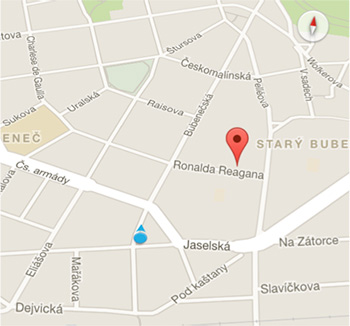 My Sunday morning was spent exploring parts of Prague that I had previously not seen. One of the things that a group member wanted to see was Ronalda Reagana Road in front of the US embassy. We had tried to find the road on a previous day but were unsuccessful, but finally we found it after walking and exploring that morning.
My Sunday morning was spent exploring parts of Prague that I had previously not seen. One of the things that a group member wanted to see was Ronalda Reagana Road in front of the US embassy. We had tried to find the road on a previous day but were unsuccessful, but finally we found it after walking and exploring that morning.
After we found Ronalda Reagana and took the obligatory pictures, a group of us went to a cafe and got some much needed caffeine and fruit. The coffee filled a much needed hole of tiredness and the grilled strawberries were one of my favorite dishes of the entire trip. This was one of the more relaxing days spent in Prague. It was fun and exciting trying to find our way through a foreign city on our own, although wrong turns were made and much backtracking was done.
Kaitlyn Darby:
After our various excursions in the morning, several of us met back up in the afternoon for lunch and the zoo. We had heard great things about the Prague Zoo and even waited to eat until we got there. I think we spent more time at the zoo than we were able to spend anywhere else. From seals when we first walked in to the hippos we saw at the end, the zoo was huge and filled with animals from all over, including the bald eagle I might add.
Most things were the same as any other zoo I have been to, but a few things stood out. For example, it seemed that almost all of the exhibits were less guarded than I was used to and certainly more accessible to the people passing by. Any person with the desire could have hopped right into any of the exhibits. Secondly, I have never been to a zoo where the tigers were shown next the iguanas or where goats were kept beside the cheetah. A couple other note-worthy quirks were the ski lift to the top of the zoo and the free-to-roam peacocks encountered on multiple occasions. Another added bonus was being able to have Emily Frame join us at the zoo. Emily is a UT student that went on the trip last year and has been studying in the Czech Republic since January.
All in all the zoo was a great way to spend the afternoon before buckling done for the evening to study. Labs start tomorrow!
May 19
Lab Summary
Eric Welch:
With the arrival of Monday came the start of our laboratory class at the VR-1 reactor, operated by the Czech Technical University. This marked the beginning of the second half of our study abroad. The first half encompassed cultural and technical visits, the second primarily encompassed eight reactors experiments followed by some independent exploring of Prague for dinners and shopping.
The experiments done included neutron detection, delayed neutron detection, reactor kinetics, reactor dynamics, control rod calibration, approach to criticality, and reactor operation. The most exciting of the experiments in my opinion were the approach to criticality and reactor operation experiments.
In the approach to criticality, we used basic calculators, graph paper, pencils, and rulers to see at what regulatory control rod height the reactor would become critical. This is the same way that the first reactor was brought to criticality, although with a different control mechanism.
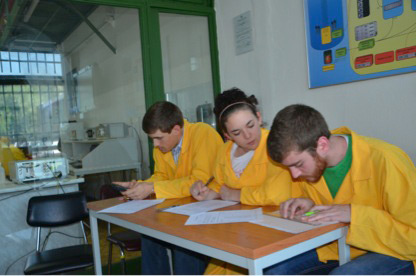
On the last day of our lab class, all nine of the students got to operate the VR-1 zero power reactor, each performing a different task. These tasks included bringing the reactor to critical, deviating and recovering from the critical position, switching between manual and automatic operation, and shutting down the reactor through SCRAM.
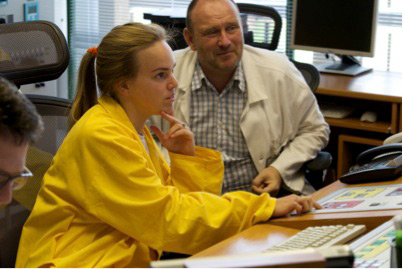
For those not versed in nuclear terminology, a few terms might need to be cleared up. Criticality means a sustainable fission state, some people are intimidated by the term but it simply means that the reactor is in a safe state of fission. SCRAM is a safety mechanism in which all of the control rods are dropped into the reactor, stopping the fissions within the reactor. The acronym comes from the saying “Safety Cut Rope Axe Man,” which refers to the original safety mechanism of stopping fission reactions: a rope, a bucket, a cadmium solution, and an axe. A zero power reactor refers to a reactor that does not require the use of a cooling system to remove heat from the fuel. The VR-1 reactor is a pool type reactor that uses natural heat convection to keep the fuel cool.
Nuclear engineering has some intimidating terminology and some scary aspects such as radiation and bad memories. But my experience at this reactor and the three other reactors that we visited, all reinforced the words that our professors have said since day one: reactors and the nuclear field are safe, but can be dangerous just like anything else if not monitored or used properly. Our education and programs like this study abroad will only help further the safety of the nuclear field and hopefully lessen future worries about the word nuclear.
